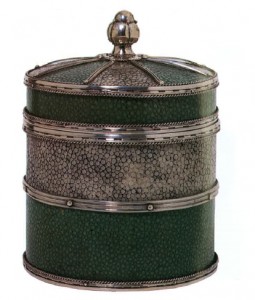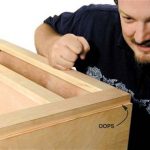We may receive a commission when you use our affiliate links. However, this does not impact our recommendations.
With the growth of hand tools in woodworking, or should I say the return to hand tools in woodworking, many up-and-coming furniture makers think that the final pass on a panel or surface is always with a smoothing plane or scraper. If you think that you may be wrong.
Furniture makers in the 18th- and early 19th-centuries did some sanding – I guess a better statement would be that they did further smoothing of the surface. Not with sandpaper as we know it, but with shagreen.
“In the time of Roubo, these abrasives would include sandpaper and shagreen (sharkskin or ray skin) pumice, or vegetable reeds and fibers,” wrote Don Williams on a Lost Art Press blog.
Shagreen can be produced from horse hides and fish skin. Shagreen made from fish skins is what was used in woodworking. This material is commonly referred to as sharkskin, but most of the shagreen is from small tropical sharks (known as dog-fish) and rays.These skins had a rough, hard surface of calcified papillae instead of scales.
Early fisherman would catch the sharks and rays, skin the fish for the flesh then stretch and dry the skins. The dried untreated skins were what carpenters and furniture makers used to smooth and polish wood surfaces.
Treated skins were leather-like. Once smooth and supple, shagreen could be dyed different colors and was often used to cover small containers, watch cases and sword handles. (The container shown above was made by John Paul Cooper in 1931.)
Today you can find many products made with shagreen or faux shagreen, but I could not find stretched and dried, untreated skins for smoothing my woodworking project. If you’re near the ocean and an avid fisherman, maybe you could revive shagreen. Or as woodworkers, maybe we can simply accept and use sandpaper.
If you are interested in learning more about finishing, there is no better place to turn than “Flexner on Finishing” by Bob Flexner. For additional information on sanding, download a copy of Robert W. Lang’s “Sanding Finishes.”
Here are some supplies and tools we find essential in our everyday work around the shop. We may receive a commission from sales referred by our links; however, we have carefully selected these products for their usefulness and quality.










Ah, but do you know what traditional English shark skinning tongs look like?
The ‘traditional’ wooden tongs look like a ‘Roubo’ folding X book stand with all equal legs and a ‘fish tailed’ tanged chisel blade stuck into one leg. The chisel is used to start lifting the skin, and once there is a flap free the skin is gripped between the legs and pulled free. The roughness of the shark skin makes it grip better in the wooden jaws of the tongs.
Shark skining was an off-season occupation in coastal whaling communities like Eden in New South Wales, Australia – the whales passed for a few weeks twice a year & the rest of the time was passed farming and catching sharks for their skins.
Glen –
I’ve always assumed that sandpaper/shagreen/sharkskin wasn’t used as much then, because it was too expensive. Do you know if that’s the case?